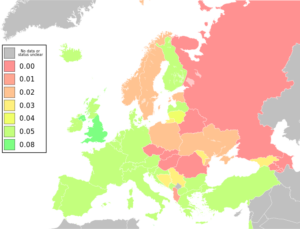
One of the persistent myths related to alcohol and driving, particularly in the US, is that drinking before driving is okay as long as you take certain precautions. Some people believe those precautions are not drinking too much; others believe in eating certain foods or drinking certain things in addition to alcohol, or spacing out drinks or driving slowly or listening to loud music or splashing themselves with cold water or…the myths are endless.
The US and Canadian Limit of .08 g/dL is Already Too High

Unfortunately, none of them are true. There is no safe amount of alcohol you can drink before driving. My definition of “safe” involves an amount of wine, beer, champagne, whiskey, liquor, hard lemonade, or any other alcoholic beverage you could consume and remain as competent of a driver in the next several hours as you would have been had you not had that amount of alcohol. In the US, the law states you can consume up to .08 grams of alcohol per deciliter of blood (known as the Blood Alcohol Concentration, or BAC, as measured by g/dL) as long as you’re over 21. However, this limit is far too high, as evidenced by the fact that approximately 1/3rd of all fatal car crashes in the US are linked to alcohol, and have been so consistently since the 1970s.
Blood Alcohol Concentration Effects Below .08 g/dL – What happens before you’re legally drunk?
The .08 limit doesn’t work; by that point, you’re long past the point of being a safe driver. Let’s take a look at what alcohol does to your body and driving abilities before you reach .08 of alcohol concentration.
.02 – You’re going to lose your judgment to some degree. This might mean saying things you ordinarily wouldn’t or doing things you normally wouldn’t with people you normally wouldn’t. You might feel more relaxed, a bit warmer, and different in your mood. To a typical person, you might appear more talkative, happier, giddy, or simply less likely to say no. Your concentration’s going to go down. That means you’re more likely to miss things–like whether that light was green or red, or whether that’s a 2-way or a 4-way stop, or whether or not a child just ran out in front of your car.
.04 – Everything above will be happening in earnest. You’re going to start exaggerating your movements, which makes sense because you’re going to have more and more trouble controlling your muscles, especially the fine ones. That might mean having trouble focusing your eyes or holding objects between your fingers. Your judgment will continue to drop, but you’re not going to notice it. That might mean going home with people you wouldn’t–which you’re going to feel good about. You’ll be less inhibited, after all, and less alert. This means your driving’s going to get worse–a lot worse. Things will get harder to track. The steering wheel will get harder to steer. Your braking will take longer. This is the point where people might start suggesting you don’t drive, if you’re lucky.
.06 – Everything above will be happening more and more quickly, and you’ll be responding more and more slowly. Your focus will continue to drop, as will your ability to discern bad ideas from good ones. You’re going to have a lot of trouble remaining faithful–whether to your values or to the people you love. And if you get behind the wheel, you’re going to have trouble staying between lanes, staying within any kind of a speed limit, staying away from moving cars, moving people, sidewalks, and police cars. In short, you’re going to be drunk. However, it’s important to remember that you were already drunk; it’s just going to be more obvious to everyone but you.
By the time you hit the legal limit, you’re already long drunk
None of these levels are against the law in the United States or Canada as long as you’re over 21. But if you’re reading this article while sober, it’s hopefully apparent that none of these levels of inebriation would be remotely safe on the roads. Or to put it more bluntly, if you wouldn’t want to be walking across a crosswalk with your spouse and children while someone barreling down the road with the physical and neurological effects described above, you intuitively understand why those limits, while legal, are unacceptably high.
If a .08 BAC is already far too high to be safe, why is it legal in the United States?

As is almost always the case when injustice and inequality exist on Earth, it comes down to money. If you visit the NHTSA’s page on drunk driving, you’ll find all sorts of information on the effects of alcohol at .08 BAC and below and statistics on the dangers of drinking and driving. However, what you won’t find is any meaningful advocacy or discussion about lowering the alcoholic limits, or references to how the limits are lower in nearly every other rich country on the planet, and how those countries suffer significantly lower rates of drunk driving (or drink driving, as it’s largely known outside the United States). Look at the map above of European BACs. Why would the US stand out so much?
There’s an awful lot of money tied up in encouraging and distributing alcohol in the US. Companies like Anheuser-Busch InBev SA/NV (who produce brands like Budweiser, Corona, and Stella Artois) make 45 billion dollars in revenue in the United States every year, and want alcohol in every home and on every occasion. And until we reduce the influence corporations have on our national policies, we’re going to continue to have lots of things that kill lots of people available in lots of places with minimal oversight–including, but not limited to guns, drugs, medication, giant cars, and alcohol.
 If you find my information on best practices in car and car seat safety helpful, you can buy my books here or do your shopping through this Amazon link. Canadians can shop here for Canadian purchases. Have a question or want to discuss best practices? Send me an email at carcrashdetective [at] gmail [dot] com.
If you find my information on best practices in car and car seat safety helpful, you can buy my books here or do your shopping through this Amazon link. Canadians can shop here for Canadian purchases. Have a question or want to discuss best practices? Send me an email at carcrashdetective [at] gmail [dot] com.

